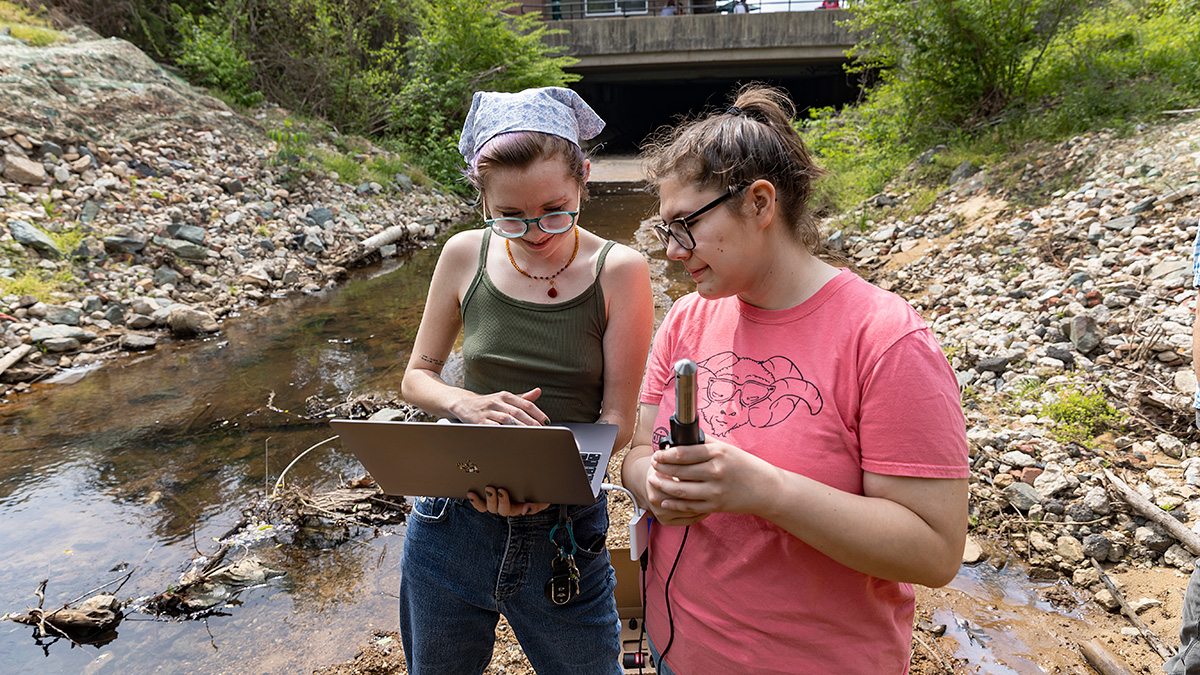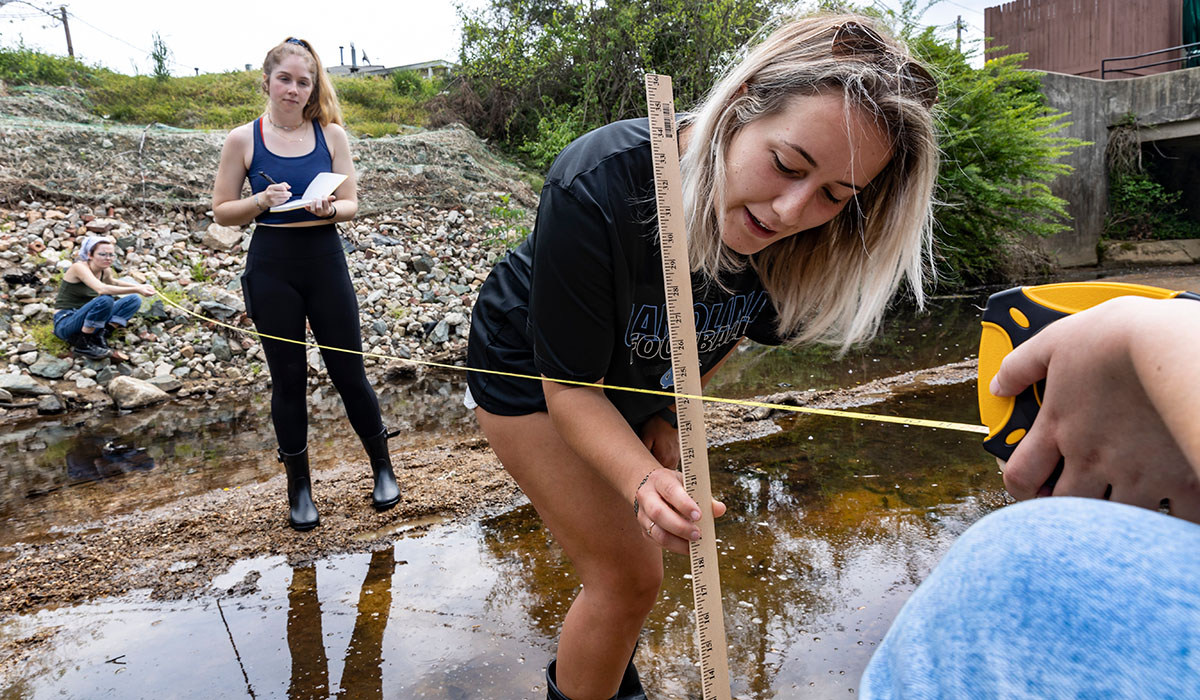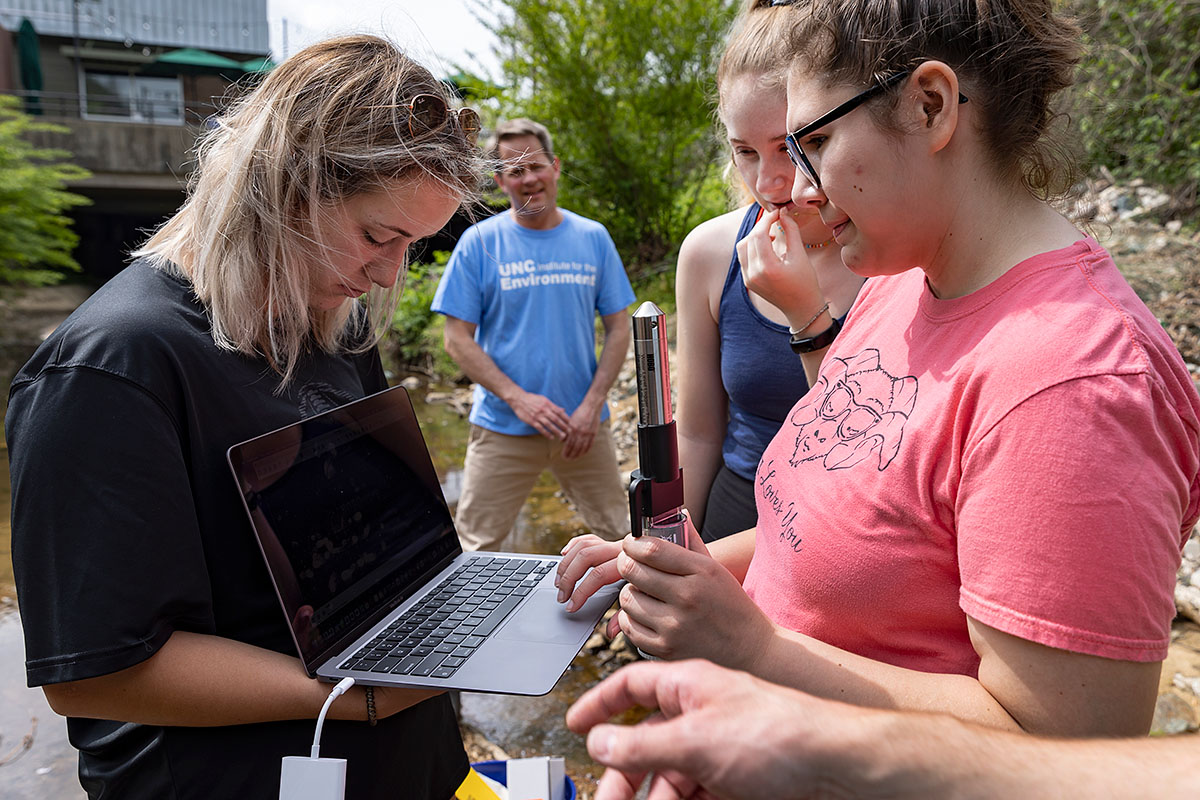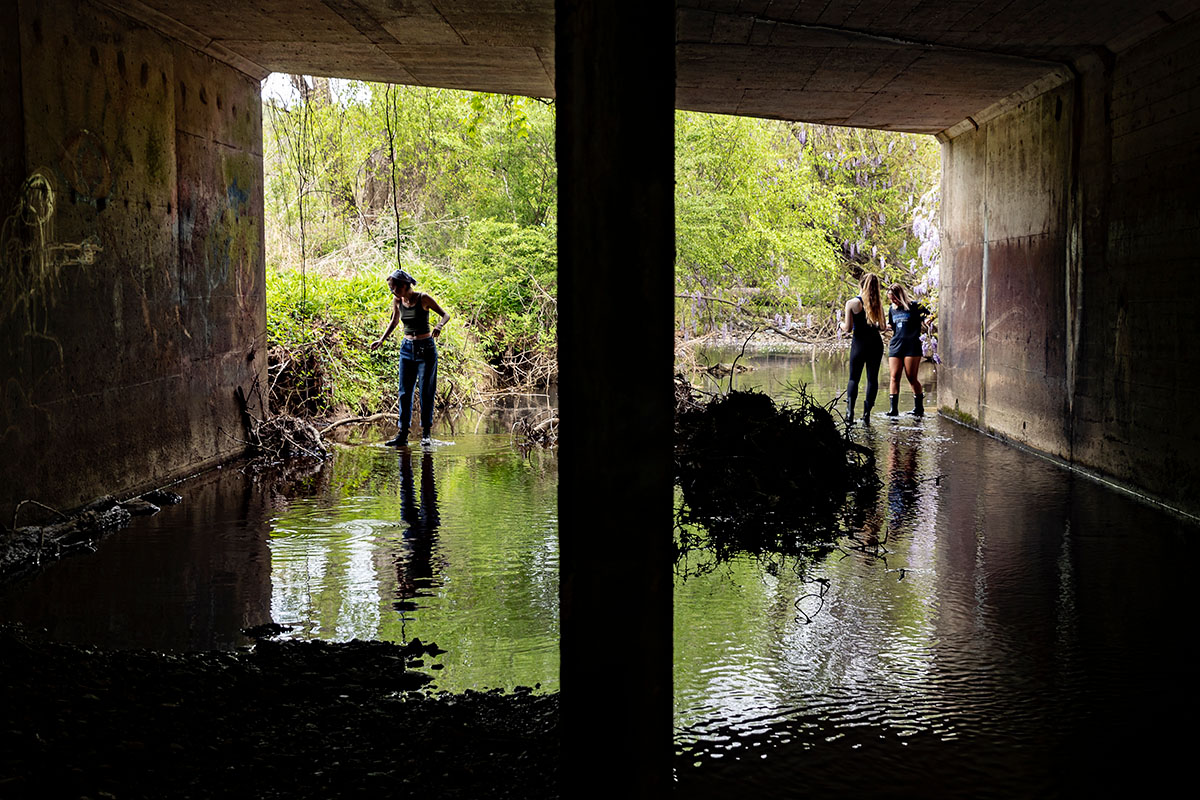Tar Heels in the field
Through the UNC Institute for the Environment's semester-long Sustainable Triangle Field Site, Carolina students are researching Chapel Hill's creeks to help the town develop stronger flood mitigation plans.

In her first three semesters as an environmental science major and GIS minor, Carolina sophomore Annabel Grocott had spent most of her time in the classroom studying subjects like organic chemistry, calculus and physics.
While the courses provided a solid foundation for her field, she wanted a new opportunity to put what she was learning into practice and get hands-on experience.
She found that chance with the Sustainable Triangle Field Site this semester.
Grocott has been — literally — getting her feet wet in environmental science through the field site, a semester-long academic program where she has been working alongside classmates and faculty experts to research environmental issues impacting Chapel Hill.
“I thought doing the field site would be a really good opportunity to delve into my major and just do sustainability stuff 24/7,” she said. “I love it. I love doing fieldwork. This is the most fun part of what we get to do — being out in nature. I’ve really enjoyed it a lot. It’s really affirmed that this is what I want to do.”
One of five field sites based out of the UNC Institute for the Environment, the Sustainable Triangle Field Site program provides experiential learning opportunities for Tar Heels interested in sustainability issues facing the University and the surrounding communities. By working closely with Sustainable Carolina, the program combines academic studies in the environment, urban planning and urban design with practical experience through internships, research projects and field trips.
“The goal of all the sites is to give the students an immersive, experiential experience. You learn about things in a different way when you are thinking about it as a group and are immersed in it throughout the week,” said Mike Piehler, a professor in the College of Arts & Sciences’ Earth, marine and environmental sciences department and the director of the UNC Institute for the Environment.
Students participating in the Sustainable Triangle Field Site program take 16 credit hours in the Department of City and Regional Planning and the Environment, Ecology and Energy Program during the spring semester, including courses on green infrastructure, seminars and a capstone project that addresses a real-world sustainability issue. This semester’s field site students chose to focus their research on the streams in Chapel Hill and flooding risks.
With the University sitting at the top of a hill, campus activities play a direct role in the health of our creeks, Piehler said, and they are a key element of Sustainable Carolina’s initiatives.
For the capstone project, the Tar Heels are researching Bolin, Booker and Morgan creeks by assessing existing resources in the community, conducting a spatial analysis of the creeks and using sensors to collect data that can be used to create models that could predict flooding.
“As years go on, future field sites can keep doing the same kind of research, and we can get a good gauge of how the watershed is changing, and hopefully that can help inform some infrastructure changes within Chapel Hill — especially if we can predict when the shopping center might flood,” Grocott said.
The students have spent the semester wadding through the creeks to take measurements themselves.

By establishing data that indicates normal water levels for the creeks, the students are providing useful tools that can help the Town of Chapel Hill analyze changes over the years.
“The idea is to get some data, to say something about timing — like where is peak water level throughout the watershed in a big storm and how long does it take to propagate downstream,” said Piehler, who also serves as Carolina’s chief sustainability officer. “Our goal is to provide data to help answer the question of, ‘If it rains really hard, what is the accompanying risk of flood, and what might the timing of the flooding be?’ Optimally, we would like to develop a local model that could be on the Weather Channel alongside the rain forecast.”
On April 29, the students will present their research to the Town of Chapel Hill to help with flood mitigation planning that can protect businesses and residences. The project also serves as a pilot for a possible University partnership with the town to establish a network of sensors in Chapel Hill’s creeks to actively monitor water levels.

Students spent the semester collecting data from Bolin, Booker and Morgan creeks to help Chapel Hill with its flood mitigation planning.
“No baseline data has been taken for the water levels of the creeks in Chapel Hill, so with this, we’re hoping to lay the groundwork for future research, especially as climate change has a bigger impact on water level,” Grocott said.
While Piehler leads the field site, the students have also worked with many University and community experts, including postdoctoral researcher Adam Gold and Antonia Sebastian from the Earth, marine and environmental sciences department. Sebastian, a hydrologist, is a member of Chapel Hill’s stormwater working group and has been working alongside the field site students to hone their research to fit the town’s needs. The model for the field site grew from a National Science Foundation Growing Convergence Research grant, which emphasizes multidisciplinary research to solve flooding challenges. That project is led by Elizabeth Frankenberg, director of the Carolina Population Center, who also worked with the field site students.
Piehler says access to renowned researchers in natural sciences, social sciences and engineering is what makes the field site so meaningful. Instead of assisting faculty members in their research, the students take the reins themselves and learn as they go.
“They start out pretty quickly doing sophisticated stuff. And through the semester, their knowledge catches up with their practice. It’s never unsettling. It’s never way out in front. But I do think it’s challenging,” he said. “I think the connection of a professor to a student in this kind of class is different because we’re not telling them what to do. We’re not lecturing to them. We’re working alongside and listening to them and helping them solve problems.”

The Sustainable Triangle Field Site students’ project could lead to a larger partnership between Carolina and Chapel Hill to install a network of sensors in the town’s creeks.
For Grocott, it’s the exact approach she was looking for when she enrolled in the field site. The ability to get her hands on tools of her trade and have the chance to get immediate feedback and guidance has helped her develop as a scientist.
The field site, Piehler hopes, turns the young researchers into well-rounded scientists ready to solve problems.
“As someone who has always done applied science, it’s really what I value and always want to do,” Piehler said. “It is so exciting to see the students gain an applied interdisciplinary perspective on a critical issue and grow both intellectually and in their ability to tackle challenges, no matter what they might end up being.”





